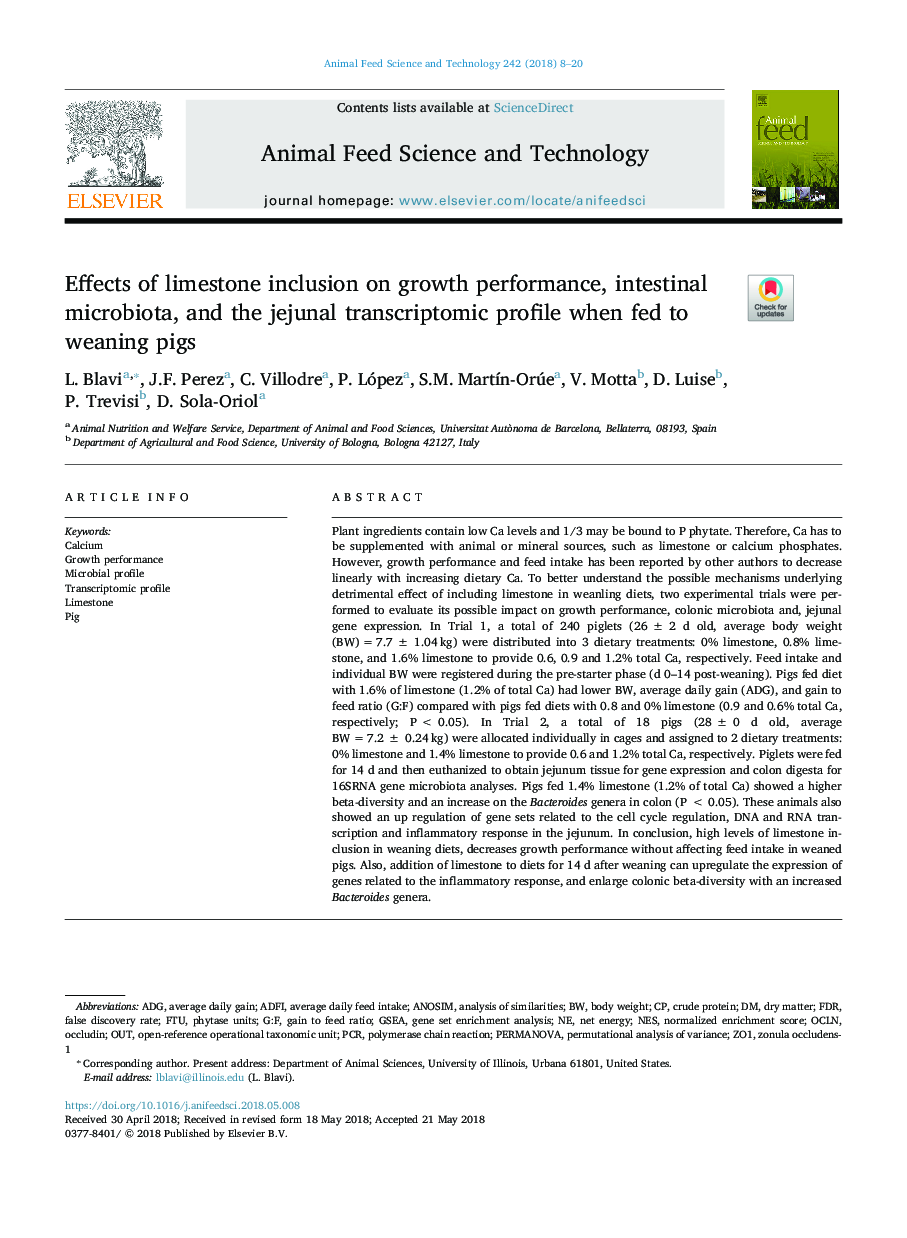| کد مقاله | کد نشریه | سال انتشار | مقاله انگلیسی | نسخه تمام متن |
|---|---|---|---|---|
| 8490920 | 1552344 | 2018 | 13 صفحه PDF | دانلود رایگان |
عنوان انگلیسی مقاله ISI
Effects of limestone inclusion on growth performance, intestinal microbiota, and the jejunal transcriptomic profile when fed to weaning pigs
ترجمه فارسی عنوان
اثرات ورودی سنگ آهک بر عملکرد رشد، میکروبیوتای روده و مشخصات ترانسکتومیک ژله در هنگام تغذیه خوک ها
دانلود مقاله + سفارش ترجمه
دانلود مقاله ISI انگلیسی
رایگان برای ایرانیان
کلمات کلیدی
Zo1OCLNGSEAANOSIMADFIADGPERMANOVAFDRpermutational analysis of variancenESphytase unitsG:F - G: Fnet energy - انرژی خالصgain to feed ratio - به نسبت خوراک به دست آوریدOUT - بیرونanalysis of similarities - تجزیه و تحلیل شباهت هاGene Set Enrichment Analysis - تجزیه و تحلیل غنی سازی مجموعه ژنیPig - خوکLimestone - سنگ آهکOccludin - عذابGrowth performance - عملکرد رشدdry matter - ماده خشکaverage daily gain - متوسط افزایش روزانهMicrobial profile - مشخصات میکروبیAverage daily feed intake - میانگین مصرف خوراک روزانهfalse discovery rate - میزان کشف کاذبnormalized enrichment score - نمره غنی سازی نرمال شدهZonula occludens-1 - نوار ابزار بسته 1FTU - واحد درpolymerase chain reaction - واکنش زنجیره ای پلیمرازPCR - واکنش زنجیرهٔ پلیمرازbody weight - وزن بدنcrude protein - پروتئین خامCalcium - کلسیم
موضوعات مرتبط
علوم زیستی و بیوفناوری
علوم کشاورزی و بیولوژیک
علوم دامی و جانورشناسی
چکیده انگلیسی
Plant ingredients contain low Ca levels and 1/3 may be bound to P phytate. Therefore, Ca has to be supplemented with animal or mineral sources, such as limestone or calcium phosphates. However, growth performance and feed intake has been reported by other authors to decrease linearly with increasing dietary Ca. To better understand the possible mechanisms underlying detrimental effect of including limestone in weanling diets, two experimental trials were performed to evaluate its possible impact on growth performance, colonic microbiota and, jejunal gene expression. In Trial 1, a total of 240 piglets (26â¯Â±â¯2 d old, average body weight (BW)â¯=â¯7.7â¯Â±â¯1.04â¯kg) were distributed into 3 dietary treatments: 0% limestone, 0.8% limestone, and 1.6% limestone to provide 0.6, 0.9 and 1.2% total Ca, respectively. Feed intake and individual BW were registered during the pre-starter phase (d 0-14 post-weaning). Pigs fed diet with 1.6% of limestone (1.2% of total Ca) had lower BW, average daily gain (ADG), and gain to feed ratio (G:F) compared with pigs fed diets with 0.8 and 0% limestone (0.9 and 0.6% total Ca, respectively; Pâ¯<â¯0.05). In Trial 2, a total of 18 pigs (28â¯Â±â¯0 d old, average BWâ¯=â¯7.2â¯Â±â¯0.24â¯kg) were allocated individually in cages and assigned to 2 dietary treatments: 0% limestone and 1.4% limestone to provide 0.6 and 1.2% total Ca, respectively. Piglets were fed for 14 d and then euthanized to obtain jejunum tissue for gene expression and colon digesta for 16SRNA gene microbiota analyses. Pigs fed 1.4% limestone (1.2% of total Ca) showed a higher beta-diversity and an increase on the Bacteroides genera in colon (Pâ¯<â¯0.05). These animals also showed an up regulation of gene sets related to the cell cycle regulation, DNA and RNA transcription and inflammatory response in the jejunum. In conclusion, high levels of limestone inclusion in weaning diets, decreases growth performance without affecting feed intake in weaned pigs. Also, addition of limestone to diets for 14 d after weaning can upregulate the expression of genes related to the inflammatory response, and enlarge colonic beta-diversity with an increased Bacteroides genera.
ناشر
Database: Elsevier - ScienceDirect (ساینس دایرکت)
Journal: Animal Feed Science and Technology - Volume 242, August 2018, Pages 8-20
Journal: Animal Feed Science and Technology - Volume 242, August 2018, Pages 8-20
نویسندگان
L. Blavi, J.F. Perez, C. Villodre, P. López, S.M. MartÃn-Orúe, V. Motta, D. Luise, P. Trevisi, D. Sola-Oriol,
